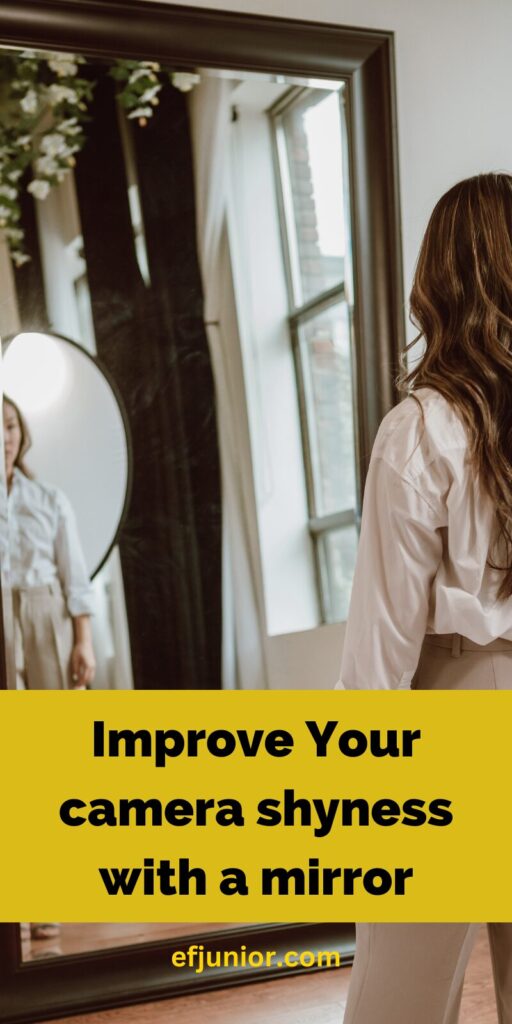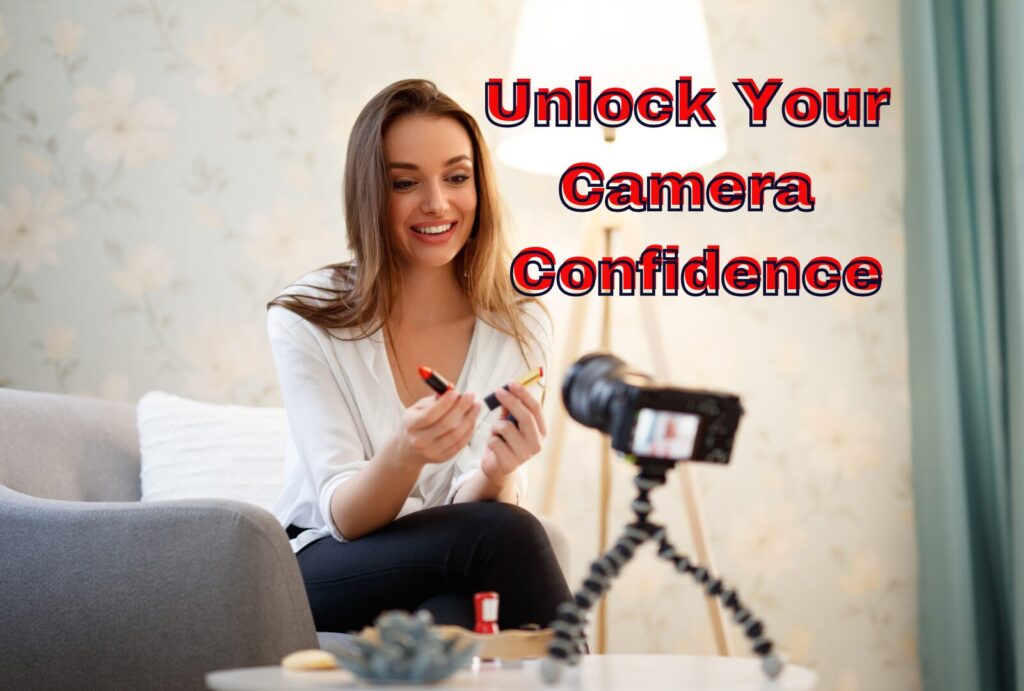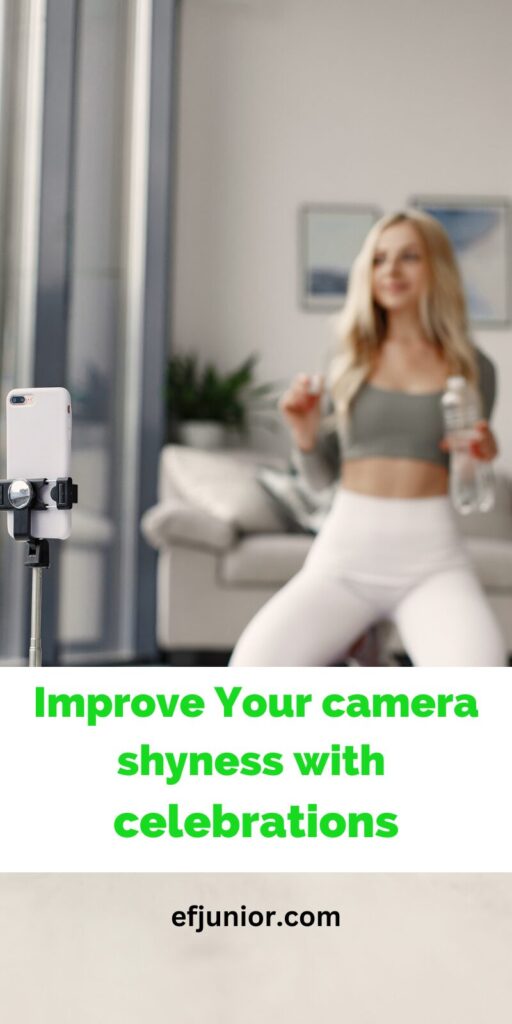Welcome, online marketers, to a journey of empowerment in video content creation.
In today’s digital age, conquering camera shyness is crucial for personal branding and success in digital marketing. Whether experienced or new, mastering confidence on camera impacts your digital ventures. Camera shyness affects individuals of all backgrounds and experience levels, yet with the right mindset and actionable strategies, it can be overcome.
In this article, we’ll delve into practical tips, expert insights, and proven techniques designed to motivate and empower you to step in front of the camera with confidence and authenticity.

Here are the expert insights of the 14 confidence-boosting tips to unlock the power of your unique presence on camera.
Tip 1. Use the “Mirror Image”
When starting your journey to conquer camera shyness, one practical step is to use the mirror to practice self-talking and gestures. Seeing yourself mirrored and talking can help alleviate the uneasiness that comes with seeing yourself on screen.
It may take some time to get used to, but once you become accustomed to this mirrored view, you’ll find it easier to engage confidently during recordings. Besides easing the initial discomfort of seeing yourself on screen, it also helps align your movements and gestures with what you see, creating a more natural presentation.
This alignment can boost your confidence as you feel more in sync with your on-screen presence. This practice allows you to become familiar with how you appear on camera in real-time.
You’ll notice that as you practice, the image becomes more natural, and you’ll feel more confident and at ease during actual recordings.

Tip 2. Slow Down While Talking
One common mistake when feeling nervous on camera is speaking too quickly. This can make your message less clear and may convey a lack of confidence. Practice speaking slowly and enunciating your words to ensure clarity and confidence in your delivery. Additionally, pacing plays a significant role in how your message is received.
A well-paced speech allows your audience to digest information effectively. Emphasize key points by slowing down slightly and giving them the necessary emphasis and attention they deserve. Don’t be afraid of pauses in your speech.
Strategic pauses can be powerful tools to emphasize points, allow for audience reflection, and create a more engaging delivery. Pausing also gives you a moment to gather your thoughts and maintain a steady pace throughout your recording.
Tip 3. Minimize Distractions While Recording
Creating the right recording environment is essential for minimizing distractions. Choose a quiet space free from background noise or interruptions. Additionally, ensure proper lighting to enhance your visibility and overall presentation quality.
Use Headphones to Block Out External Noise and Focus on Your Speech: Headphones can be valuable tools to block out external noise and help you focus solely on your speech. They create a more immersive experience, allowing you to concentrate on delivering your message confidently without distractions.
Remove Clutter from Your Filming Space to Minimize Visual Distractions: A clutter-free filming space contributes to a professional and focused presentation. Remove any unnecessary items or clutter from the background to keep the viewer’s attention on you and your message. A clean and organized environment also reflects positively on your attention to detail and preparation.
Tip 4. Address Scopophobia and Fear of Being Looked At
Scopophobia, or the fear of being looked at, is a common challenge for those overcoming camera shyness. Identify specific triggers or fears related to being on camera, such as fear of judgment, comparison, or scrutiny.
Once you’ve identified your fears, develop practical strategies to manage and overcome them during filming. This may include positive self-talk, visualization techniques, or gradual exposure to camera-related situations.
Practice Positive Self-Talk and Affirmations to Boost Confidence: Positive self-talk and affirmations can be powerful tools to boost confidence and shift your mindset from fear to empowerment. Repeat affirmations that reinforce your abilities and focus on your strengths rather than perceived shortcomings.
Tip 5. Understand Shyness and Social Anxiety
Understanding the underlying psychological aspects of shyness and social anxiety can provide valuable insights into your camera shyness. Educate yourself on topics such as cognitive distortions, self-image, and fear of rejection to gain a deeper understanding of your challenges.
If camera shyness stems from deeper-rooted issues such as social anxiety or self-esteem issues, consider seeking professional guidance or support. A therapist or counselor can provide personalized strategies and techniques to help you manage and overcome these challenges effectively.
Exposure therapy involves gradually exposing yourself to feared situations or stimuli in a controlled and supportive environment. Apply exposure techniques to camera-related scenarios, starting with less intimidating situations and gradually progressing to more challenging ones.

Tip 6. Manage Anxiety Effectively to Stop Being Camera Shy
Incorporate relaxation techniques into your routine to manage anxiety effectively. Deep breathing exercises and visualization can help calm nerves and create a more relaxed state of mind before filming.
Create a Pre-Recording Ritual to Calm Nerves and Boost Confidence: Develop a pre-recording ritual that includes activities or routines that calm your nerves and boost confidence. This could be listening to calming music, practicing affirmations, or engaging in a brief meditation session.
Create a Pre-Recording Ritual to Calm Nerves and Boost Confidence: Develop a pre-recording ritual that includes activities or routines that calm your nerves and boost confidence. This could be listening to calming music, practicing affirmations, or engaging in a brief meditation session.
Tip 7. Combat Nervousness with Effective Relaxation Practices
Regular meditation or mindfulness practice can help reduce overall anxiety and promote a sense of calmness. Incorporate these exercises into your daily routine to build resilience against nervousness.

Use Progressive Muscle Relaxation to Release Tension Before Filming: Progressive muscle relaxation involves tensing and then relaxing different muscle groups to release tension and promote relaxation. Use this technique before filming to ease physical symptoms of nervousness.
Tip 8. Address Concerns About Appearance on Camera
Your appearance plays a role in how you feel on camera. Experiment with different hairstyles, makeup looks, and clothing styles to find what boosts your confidence and makes you feel comfortable and authentic.
Practice Positive Body Image Affirmations to Boost Confidence in Your Appearance: Affirmations can help improve body image and boost confidence. Practice positive affirmations that focus on self-acceptance, self-love, and confidence in your appearance.
Tip 9. Use Body Language to Convey Confidence
Body language plays a significant role in how we are perceived on camera. Practice open and assertive body language, such as maintaining eye contact, using gestures purposefully, and standing or sitting with good posture.
Use Gestures and Facial Expressions to Engage Your Audience Effectively: Gestures and facial expressions can enhance your message and engage your audience. Use them strategically to convey emotions, emphasize points, and maintain audience interest throughout your recording.
Tip 10. Explore Social Media’s Impact on Camera Shyness
Understanding the benefits of video messaging can reshape your perspective on camera shyness. Social media exposure can influence how we perceive ourselves and others.
Analyze how constant exposure to curated images and content on social media may contribute to camera shyness and self-doubt.
Develop strategies to manage social media anxieties and maintain confidence: Set boundaries with social media and develop strategies to manage anxieties related to comparison or self-image.
Focus on authenticity in video messages and meaningful interactions rather than seeking validation through likes or followers. Avoid excessive comparison on social media platforms and focus on authentic self-expression.
While appearance is important, focus primarily on your message, expertise, and delivery. Shift your attention from appearance details to conveying valuable content and engaging with your audience effectively.
Tip 11. Experiment with Different Filming Locations
Exploring different filming locations can have a profound impact on your comfort and confidence.
Different settings, such as indoor spaces, outdoor environments, or professional studios, can evoke different emotions and energies.

Film in natural settings to create a more relaxed and authentic vibe: Natural settings can add authenticity and charm to your recordings. Consider filming outdoors or in natural light settings to create a relaxed and genuine vibe that resonates with your audience.
Lighting, background visuals, and overall ambiance contribute to the quality of your recordings. Consider these factors when choosing filming locations to create a visually appealing and engaging presentation.
Tip 12. Take Breaks to Recharge and Avoid Burnout
Long filming sessions can be draining, both mentally and physically. Use break times to stretch your body, stay hydrated, and clear your mind from distractions or stressors for optimal performance during filming.
Incorporate mindfulness or meditation practices into your break routine: These techniques can help reduce stress, enhance focus, and promote a calm mindset, leading to improved performance during filming sessions.
Tip 13. Set Realistic Goals for Improvement
Setting realistic goals is key to continuous improvement. Reflect on your previous recordings and identify areas where you can improve your on-camera presence. Break down your improvement goals into manageable steps and set realistic timelines.
Track your progress regularly and celebrate small milestones along the way: Acknowledge and celebrate your achievements, no matter how small. Recognizing your progress and accomplishments boosts motivation and reinforces positive habits and behaviors.
In conclusion, mastering camera confidence is a journey of self-discovery and continuous improvement. By implementing these actionable tips and strategies, you can conquer camera shyness, embrace authenticity, and unlock your full potential as a confident content creator. Your unique voice and message deserve to be shared confidently with the world.

FAQ Section
Is it normal to feel nervous in front of the camera?
Yes, feeling nervous is a common experience, especially when starting. It takes practice and self-confidence to become comfortable on camera.
How can I overcome my fear of being judged by others?
Focus on your message and the value you provide. Remember that everyone has insecurities, and authenticity resonates with audiences more than perfection.
What if I don’t like the way I look on camera?
Experiment with different angles, lighting, and outfits to find what makes you feel confident. Remember, your expertise and message are more important than appearance.
How can I stay calm and composed during filming sessions?
Practice relaxation techniques like deep breathing, meditation, or visualization. Establish a pre-recording ritual to calm nerves and boost confidence.
What if I make mistakes or forget what to say?
Embrace imperfections as part of the learning process. Use editing tools to refine your content and consider scripting key points to stay on track during filming.


